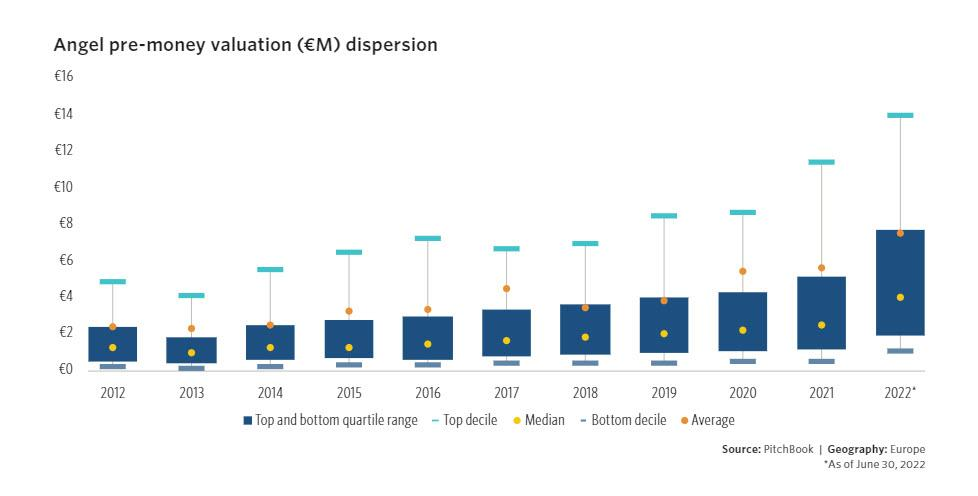In this email, I will give you some tips on how to squeeze the most out of your strategy day.
But first, an interesting chart about angel round valuations.

A few observations on the chart above:
– The spread between the valuations is increasing with increased valuations.
– Even the bottom decile of round valuations has doubled between 2021 and 2022 H1.
I think 2022 H2 will look different. But there is usually a lag between open market and private when it comes to valuations. So it might take longer for it to catch up.
Keep in mind these numbers are for closed rounds.
I meet with some founders who don’t get the valuations they ask for and then don’t do the rounds at all. Waiting for better times to hopefully come. This behavior drives up the valuation statistics.
But let’s now get back to the topic of strategy days.
Your board is your extended team, use them wisely during your strategy day
I’ve been attending (and facilitating), more than a few strategy days in my professional life. Both with startups and mature companies. To get the most out of them, you need to prepare accordingly.
It’s only fair to both yourself and your attendees who are investing a day to drill deep into your company. Do not wing it by putting together some slides the night before!
Get help to facilitate if we don’t have the skills or the time needed
Facilitation is a craft. Some people have this as their main profession. Like mgmt consultants or agile coaches.
If you are not used to it, I suggest you get some help. It’s worth it. You will get a lot more out of the time with your senior advisors.
How much time should you expect to spend on preparing for important meetings such as a strategy day?
I’d say a rule of thumb is to spend 2 – 3 times more time preparing than the actual meeting time you have set up.
And on top of that, count on spending time summarizing the information you have gathered during the strategy day. Expect to spend as much time doing this as we spent in the meeting itself.
This means that if you have 6 hours of strategy session, you should spend at least 12 hours preparing and another 6 hours summarizing afterward.
Wait, why do I have to spend all this time preparing?
If you don’t prepare, then you can’t expect to get much out of the day. You get the answers you deserve. And this is based on the questions you ask.
You need to avoid the meeting degenerating into an open discussion flowing back and forth. Opinions are thrown around. With the most extroverted and vocal people take up most of the space in the discussion.
It’s also fair to the attendees. They have sliced out a day of their time to help you out. They want to help. But you need to facilitate it to happen.
But what on earth are we supposed to do with all this preparation time?
Think about what you want to get out of the day
Do you want more input and ideas on what to do next with the product?
Or to get everyone’s insights on how the market operates?
Maybe you want to be decisive. Make decisions. Should we expand to another country? Or with another product? Or keep pursuing the market segment we currently are in?
Write it down. What questions should be answered by the end of the day? Use it as a guideline when building the agenda for the day.
Prepare lots of data for everyone to get on the same page
You need to pull out lots of data connected to the problems you will be discussing and trying to solve. To lay out the strategic landscape.
Entering a new market? Then have a market analysis in place with competitors, current customer base, and so on.
Thinking about trying out a new packaging of the product? Then have the numbers ready for your current products. Maybe some benchmarking of others doing similar packaging. And an outline of what the packaging would look like.
Want to expand the team? Prepare your burn rate. A forecast of how things would change with more people and how this new person would fit into this picture.
Start the day with a round-the-table where everyone put their expectations on the table
Voice your expectations. Remember to set the scene right. It’s fair to ask everyone to be fully present in the meeting. Ask people to put away their devices.
The board is there to help you. Ultimately, you should strive to get the information you need to push your business forward.
Break the ice. Make everyone talk.
During the day: Have timeboxed exercises with a mix of group work and time for attendees to think on their own
Your day should have a tight running schedule. With different exercises to run through.
If the whole day is an open roundtable discussion you will only see a fraction of the possible results. It becomes consensus-driven.
There should be enough post-its from each participant produced to make Greenpeace concerned.
And make sure to have breaks to get energized. Make people get up from their chairs.
End the day with a summary, reflections, and next steps
End the day with some reflections from each person.
Summarize what happened. Agree on what the next step will be. We can not count on the board to spend more time on our questions than we have set for the strategy day.
The attendees will leave the room, and we will be left there with what the group came up with. And it will be our responsibility to make this useful for our company.
Probably the next time you see them is at the next board meeting. And they will then expect to see some progress based on the work they put in during the strategy day.
Good luck! And let me know if you need some help!
3 books I’ve read / re-read lately
- Hooked: How to Build Habit-Forming Products, by Nir Eyal– A good read for you who are into building product experiences. Nir explains his model consisting of the steps Trigger, Action, Reward, and Investment. It’s built on human psychology. Both are entertaining and applicable.
- Crossing the Chasm, by Geoffrey Moore– A must-read for anyone building a b2b company or working on business-to-business sales. Published in the ‘90s, but still relevant.
- The Startup Way, by Eric Ries – This is the bible for all product people. Both large organizations as well as startups. The sequel of “The Lean Startup”. Eric coined the term MVP (Minimum Viable Product). Jump straight to The Startup Way as it is better structured and more thorough.
Do you know someone who would benefit from reading this email? Forward it to them right now.
Best,
/Chris








